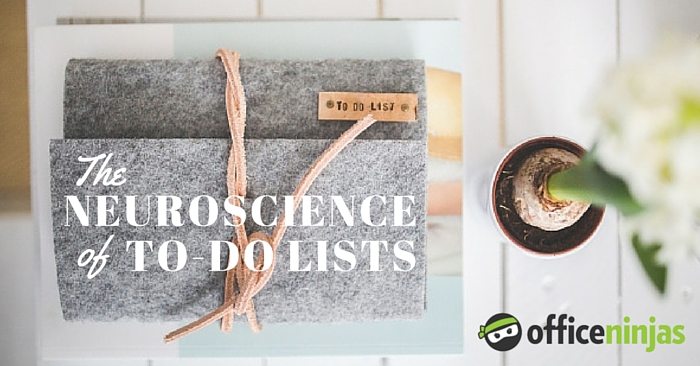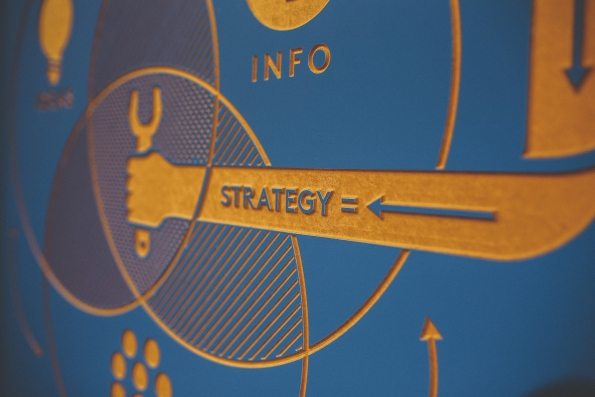3 Neuroscience Hacks to Improve Your To-Do Lists

There are two kinds of people in the world: those who make lists and those who do not. Which group do you think Office Ninjas fall into? Thought so.
We love lists. We love reading them. We love making them. We love ticking them off. The web is filled with lists: the low-, the high- and the middlebrow—everything from “22 Cat Photos That Look Like Your Ex” to “12 Maps that Explain Whats Happening in Syria”. Lists are so consistently popular that Buzzfeed has built a global publishing company on the back of them. The dozens of list-making apps around are further evidence of our list-love, not to mention our fondness for the time-honoured pen and paper.
We know we love lists, but why do we love lists?
In fact, it’s our brains that love lists—it’s the preferred method of receiving and organizing information. According to this fascinating New Yorker article, we process information spatially. Say you’re writing a grocery list. It’s actually easier to remember everything if we write down information line by line in bulleted, or numbered, points rather than in blocks of text—so if you forget your grocery list, it’s easier to remember if you wrote it in list form Not to mention that lists reduce a “paradox of choice”—the phenomenon that the “more information and options we have, the worse we feel.” The more we know about how long a task will take (especially when we prioritize tasks), the more we feel inclined to complete the task, according to scientists.
Additionally, recent studies have suggested that the key to a more organized mind and productive brain is to make to-do lists. The brain’s working memory is used to store information on a short-term basis. Most people can only hold about four things in their mind at one time, according to neuroscientist Dr. Daniel Levitin, author of The Organized Mind. Asking our brains to store more than is optimal causes our performance to suffer (so enough with multitasking, Office Ninjas!).
This is where lists come in. A to-do list of tasks frees up space in your brain to work on a current project and reminds you that you still have other tasks to achieve.
Tangible vs. Digital To-Do Lists

Paper and pen or digital apps? Well, there are two subgroups of people who make to-do lists: those who prefer tangible lists and those who prefer digital lists.
Some Office Ninjas are creatures of habit. Notebooks, pens, paper, post-its—anything that’s tangible. As Cindy B. put it, “Paper and pen still works best for me. I’ve used Outlook, OneNote and Evernote and none of them are as useable and accessible as a notebook when your executive is rattling off a list.”
Others, like Karen S., have opted for a mix of both, even though it can add complexity. “I keep a paper calendar and an online calendar. I have my to-do/tasks lists on both. I categorize them as follows: A, B, C. When complete, I place a checkmark beside it, when cancelled, I place an X beside it, when pending, I place a bullet beside it, if moved forward I place a forward arrow beside it. For me this is a holdover from what I learned when I previously used Franklin Covey, and Day-Timer systems. You have to remember to ‘sync’ your paper calendar with your online calendar. This works for me, but might be overkill to some.”
Some opt for one tool at a time, like Suzzane A. “I use tasks in Outlook to track deadlines, especially the future ones, but there is nothing more satisfying than crossing things off a list!”
But does it matter whether you use digital apps or pen and paper?
Science seems to confirm what we already know: writing down things helps you remember better. This study found that students remember lectures better when they’ve taken handwritten notes rather than typing and do better on tests as a result.
However, there is certainly ease in having all your work in a digital space. Perhaps hybrid methods are the best bet?
Three Neuroscience Hacks to Improve Your To-Do Lists

Finally, what you’ve all been waiting for—a way to improve your to-do lists!
*Cricket noises.*
Okay, so we know that plenty of you Office Ninjas have your system and know how it works for you. Awesome. But you can always improve how you approach your to-do lists. Here’s how.
1. Multitasking Is the Worst
In an interview with Dr. Daniel Levitin with the Washington Post, he says, “The reason we think we’re good at [multitasking] is just self-delusion. The brain is a very good deceiver. Multitasking puts us in a kind of dopamine addiction loop, which is similar to cocaine addiction. Each time we do some little new task, our brain rewards us with a tiny shot of dopamine, the pleasure neurochemical. For our ancestors, this was a motivating force to be active and get things done. Today, even answering an email or responding to a tweet gives out these little dollops of reward.”
We bet you’re going, “See? Multitasking makes us happy. It allows me to be an office warrior instead of a ninja.” Yes, true, but Dr. Levitin wasn’t finished. He continues, “There was a famous study in the 1950s where rats were given an opportunity to press a bar that would release dopamine in their brains. They pressed that bar to the exclusion of everything else, including eating and having sex and sleeping and drinking. They died of starvation and thirst because the dopamine became more important. We have to train ourselves. We have to enforce time away from these things because it can be a real addiction, a chemical addiction.”
So basically: multitasking is the worst. Long live to-do lists.
2. Just Writing it Down isn’t Enough
Writing tasks down is important, but it’s essential to assign priorities at the same time. According to Dr. Levitin, speaking to WNYC, “During the day when information comes in, you’re not quite sure how important it is, or how important it’s going to be. [If] you have no system for it, you can’t attach it to anything on your priorities list. And so you put it in your brain and you kind of toss it and turn it around, and because it doesn’t attach to anything, it takes up neuro-resources.”.
Dr. Levitin also explains that failure to assign priorities and thereby get important things done results in the release of stress hormone cortisol, which happens when we’re trying to do more than we can handle. It produces anxiety, shuts down your immune system and makes your stomach ache—yikes. Even something as simple as clutter produces cortisol, particularly in women, who tend to be more susceptible to clutter-induced stress.
3. Take Breaks
Have you heard of the Pomodoro Technique? It’s a focusing technique that sets a timer to 25 minutes to singularly focus in on one task while also helping you learn how long it takes you to complete a task to manage your time more efficiently. Afterward, you are rewarded with a five-minute break.
Scientists differ on when the optimum time for a break is—some suggest to work for 52 minutes and then break for 17. Either way, studies show that taking breaks helps productivity and creativity.
What do you think about to-do lists, Ninjas? Are you a proud paper and pen worker or digital all the way? Do you commit the cardinal sin of multitasking? Sound off below.
which scientific papers is your reference for the evidence todo list increase the dopamine in the body?
Multi-tasking is a habit I’m really trying to stop. Prioritizing is tricky at times, especially when everything feels like it’s #1 on the list.
Great article!
Guilty of multi-tasking. The release of cortisol (previously unkown to me) is a major factor. Thanks for this eye-opening article!
If physically writing down lists is useful, we have a whole generation being raised not knowing cursive writing. I so disagree with that approach and the research quoted in this report gives reason why. Great article and useful tips, thank you!
We’re so glad the post resonated with you Marion :)